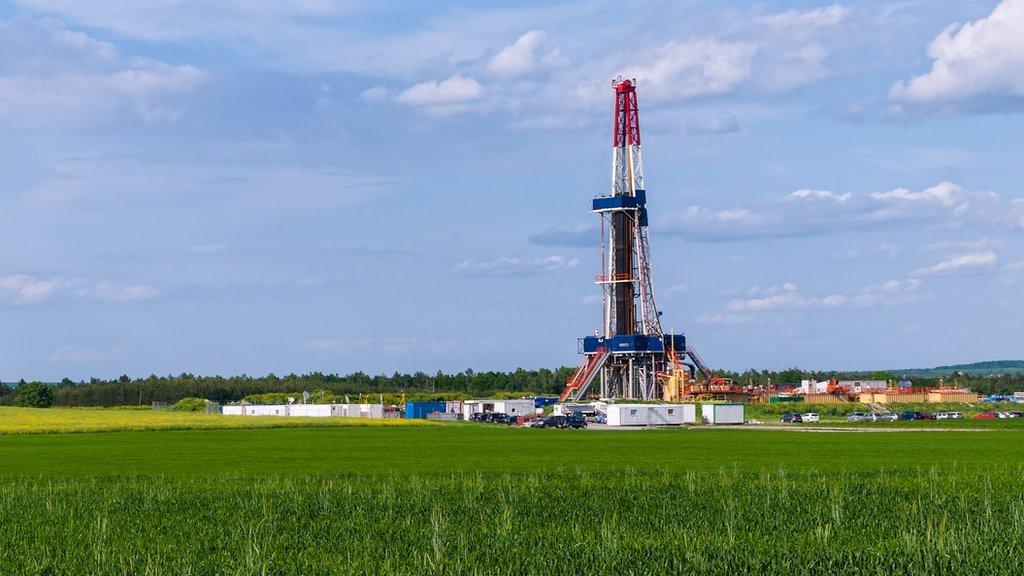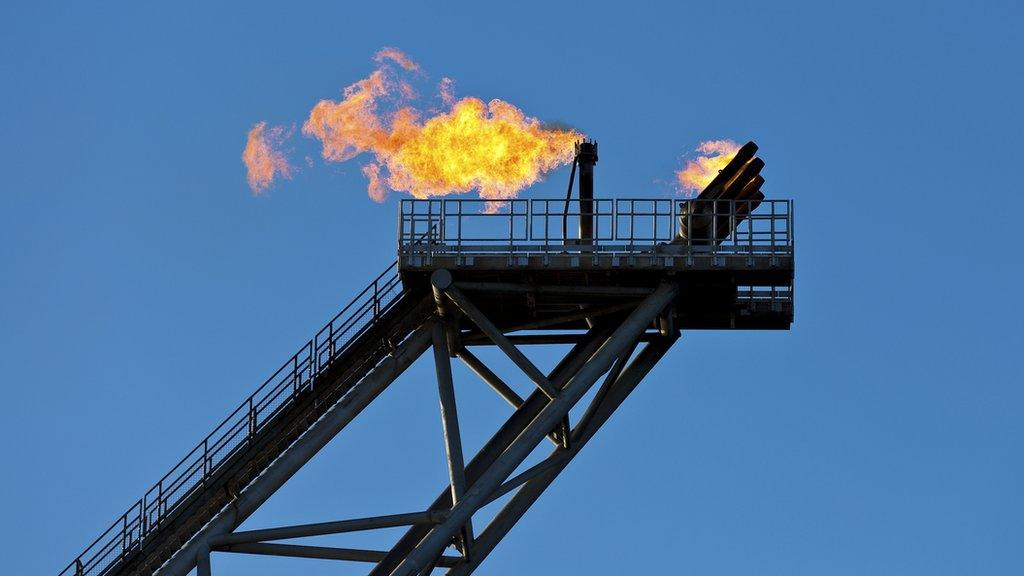Offshore oil hunkers down
- Published

Offshore oil and gas has previously used the vast scale of its Offshore Europe event in Aberdeen to showcase how big and bold it is.
This week: not so much. The industry is hunkered down, counting the cost of contraction.
There are still riches to be made from exporting, and Aberdeen is doing that well. But in the UK sector, one insider told me that quite a few companies are "simply waiting to be bought". There's nowhere else to go.
Every week brings more redundancies. Last week was Expro. This week, ConocoPhillips put us on stand-by for more bad news on that front, thought most of it in North America.
Financial restructuring is required to stay afloat. Iona Energy and Independent Oil and Gas are two North Sea-focused drillers that have been struggling to keep it together in the short term.
The recent collapse of Fletcher Shipping, leasing offshore supply ships and based in Portlethen, shows what happens when day rates plummet from £18,000 to £3000. (We've yet to hear how much the Scottish government's investment fund lost in that pre-pack administration.)
Deal-making
The annual economic report from industry body Oil and Gas UK notes that expectations of an acquisitions boom haven't been met, yet. Talisman and BG are two big firms being taken over this year, but others seem to be on hold.
Perhaps it is because deals will become more attractive once firms have run out of cash, working capital and other options. The expectations when the oil price appeared to bottom out last January was that the price would be rising by now, as supply constraints kicked in.
But while demand for energy from China has been slowing up, the US shale industry continues to produce, and OPEC has been surpassing its own agreed limits.

The shale gas industry has survived the long spell of low oil prices
Platts, the industry data specialist, has just released its latest take on OPEC production, saying the battle is not to maintain the cartel's control of pricing, but for market share of its 31 million barrels of daily production.
The Saudi-led group has realised that its tactics are not going to kill off US shale, where they can quickly start fracking again as prices rise, and Iran is preparing to come back into the market post-sanctions. So from the Persian Gulf to Venezuela, they're going to have to look to a new strategy.
Hunkered down
With that background, it's become harder to see when prices might rise again, and when they do, it doesn't look like being a return to dollar gushers.
Seventy dollars is thought to be the price at which US frackers can move in to the market to boost supply and keep prices from rising further. The price of Brent crude has risen in the last week from below $43 to around $48.
Having hunkered down for several months, North Sea firms are now having to move on to Plan B, for a sustained period of much lower prices.
That's where Oil and Gas UK, along with the new offshore regulator, have been trying to provide a route map from short-term cost-cutting to a big drive on efficiency, to a transformation of the industry. And all within around three years.
The figures about recent developments underline the need for something transformational. Within the Oil and Gas UK report, here are some elements worth noting.
Pumping more
If you like hydrocarbons (and plenty people think they should stay in the ground), the good news is that production is on the rise. Fifteen years after its decline began and after some sharp declines in recent years, UK offshore production is up 3% in the first half of this year.
If Petrofac can finally sort out its miserable project management of Total's Laggan-Tormore field west of Shetland, then the start of gas from that should push 2015 production into the first increase since 2000.
Other plans have drifted. Of 15 new fields due to come on stream this year, a third have already been pushed into 2016.

Big new fields should push the numbers up further - by 4% next year, then 3%, then 6%, to reach 1.7 million barrels per day by 2018. That's still well under half the peak production in 1999, but it shows what you get from investment spend peaking at a colossal £14.8bn last year.
Following through on investment decisions taken before the oil price fell, investment is holding up at around £11bn this year. That is dominated by only four huge projects east and west of Shetland; Mariner, Kraken, Schiehallion and Clair Ridge.
As these move towards production, that investment spend falls sharply - by £2bn to £3bn for the next three years. With a lower oil price, new projects simply aren't being sanctioned.
Cash on the barrel head
Even before prices fell, the UK offshore industry had figured out that its costs were spiralling dangerously.
They are trying to get those costs down, through collaboration, sharing the best ideas for efficiency and standardised processes so that more can be shared.
If it has recently cost £17.80 to produce the average barrel, you might think there ought to be a healthy profit. But to that, you have to add £13.60 development costs. Translate that into dollars, and the combined cost is $49.30 - just above the current barrel price.

That simplifies things a bit, so it's worth looking at the spread of costs.
More than 50 fields were producing oil last year at a cost of less than £10 per barrel, so it continues to look profitable. Around 10 were doing so for at least £40, and a couple for more than £60. Fields cost per barrel tend to rise sharply as they near the end of their working lives.
Explorers
As old fields dry up, the industry's hope is that they can be replaced. UK drillers would like something like the vast Johann Svardrup field, recently discovered within a developed area just across the sea boundary with Norway.
(The astonishing field announced last week off the coast of Egypt, containing an estimated 30 trillion cubic feet of gas, would be even more welcome.)
But hoping is about all they're doing. So far this year, only seven exploration wells have been sunk. That's in line with recent years, and the appetite for taking risks in the UK sector are diminished by a dire success rate.
In the three years 2012 to 2014, only 165 million recoverable barrels have been found. Last year's finds amounted to only 60 million barrels.
That may sound a lot if you buy your fuel by the litre and tankful. But at current rates of production, that would last little more than three months of pumping.
At that rate of success with exploration, the estimate of between two and nine billion of yet-to-find UK oil and gas looks like being very optimistic.
So what about going after the reserves they know they've got? The Oil and Gas UK economic report points to analysis suggesting there are nine billion barrels found but not developed, from 300 discoveries.
Most of these were found before 2000, and even with the oil price consistently above $100, they still weren't attractive enough to develop.
So what to do? Cue - yes, you've guessed correctly - the industry's call for more tax incentives.